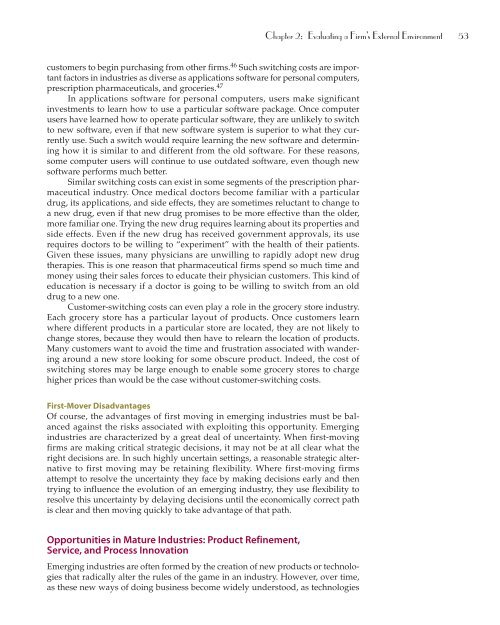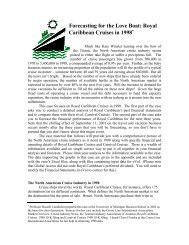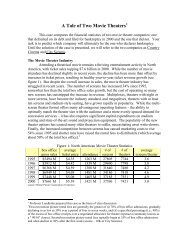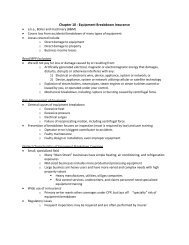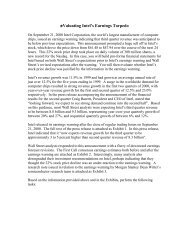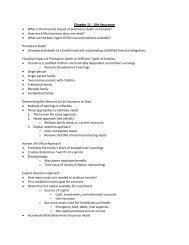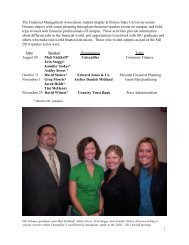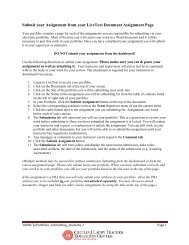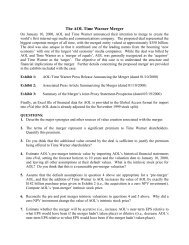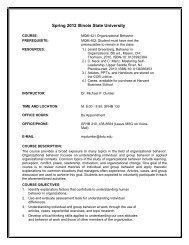Evaluating a Firm's External Environment - Illinois State University
Evaluating a Firm's External Environment - Illinois State University
Evaluating a Firm's External Environment - Illinois State University
Create successful ePaper yourself
Turn your PDF publications into a flip-book with our unique Google optimized e-Paper software.
M02_BARN4586_03_SE_C02.qxd 7/1/09 7:34 AM Page 53<br />
Chapter 2: <strong>Evaluating</strong> a Firm’s <strong>External</strong> <strong>Environment</strong> 53<br />
customers to begin purchasing from other firms. 46 Such switching costs are important<br />
factors in industries as diverse as applications software for personal computers,<br />
prescription pharmaceuticals, and groceries. 47<br />
In applications software for personal computers, users make significant<br />
investments to learn how to use a particular software package. Once computer<br />
users have learned how to operate particular software, they are unlikely to switch<br />
to new software, even if that new software system is superior to what they currently<br />
use. Such a switch would require learning the new software and determining<br />
how it is similar to and different from the old software. For these reasons,<br />
some computer users will continue to use outdated software, even though new<br />
software performs much better.<br />
Similar switching costs can exist in some segments of the prescription pharmaceutical<br />
industry. Once medical doctors become familiar with a particular<br />
drug, its applications, and side effects, they are sometimes reluctant to change to<br />
a new drug, even if that new drug promises to be more effective than the older,<br />
more familiar one. Trying the new drug requires learning about its properties and<br />
side effects. Even if the new drug has received government approvals, its use<br />
requires doctors to be willing to “experiment” with the health of their patients.<br />
Given these issues, many physicians are unwilling to rapidly adopt new drug<br />
therapies. This is one reason that pharmaceutical firms spend so much time and<br />
money using their sales forces to educate their physician customers. This kind of<br />
education is necessary if a doctor is going to be willing to switch from an old<br />
drug to a new one.<br />
Customer-switching costs can even play a role in the grocery store industry.<br />
Each grocery store has a particular layout of products. Once customers learn<br />
where different products in a particular store are located, they are not likely to<br />
change stores, because they would then have to relearn the location of products.<br />
Many customers want to avoid the time and frustration associated with wandering<br />
around a new store looking for some obscure product. Indeed, the cost of<br />
switching stores may be large enough to enable some grocery stores to charge<br />
higher prices than would be the case without customer-switching costs.<br />
First-Mover Disadvantages<br />
Of course, the advantages of first moving in emerging industries must be balanced<br />
against the risks associated with exploiting this opportunity. Emerging<br />
industries are characterized by a great deal of uncertainty. When first-moving<br />
firms are making critical strategic decisions, it may not be at all clear what the<br />
right decisions are. In such highly uncertain settings, a reasonable strategic alternative<br />
to first moving may be retaining flexibility. Where first-moving firms<br />
attempt to resolve the uncertainty they face by making decisions early and then<br />
trying to influence the evolution of an emerging industry, they use flexibility to<br />
resolve this uncertainty by delaying decisions until the economically correct path<br />
is clear and then moving quickly to take advantage of that path.<br />
Opportunities in Mature Industries: Product Refinement,<br />
Service, and Process Innovation<br />
Emerging industries are often formed by the creation of new products or technologies<br />
that radically alter the rules of the game in an industry. However, over time,<br />
as these new ways of doing business become widely understood, as technologies


